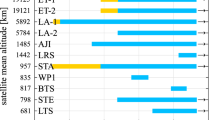Abstract
Satellite laser ranging (SLR) as a proven geodetic technique provides a wide and significant contribution to scientific studies of the Earth/Atmosphere/Ocean systems. In particular, modelling of the Earth and pole tides plays a very important role when analyzing SLR data. The accuracy of the determined satellite orbits is highly dependent on the models used for dynamic orbit determination. Gravity field models, which are represented by a series of spherical harmonic coefficients, have an impact on the satellite orbit and its precision. In addition, different empirical model parameterization used during SLR data analysis also has significant influence on the computed spherical harmonics, satellite orbits and their accuracies. In this contribution we investigate the impact of different SLR parameterizations on gravity field models used for precise satellite orbit determination. Data from satellites LAGEOS 1 and 2 were analysed using four different parameterization schemes namely: IERS1, IERS2 and IERS3 Earth tide models and pole tides. These are compatible Earth tide models of different complexity derived from IERS2010, a standard model of the International Earth Rotation and Reference Systems Service (IERS) and the standard IERS2010 pole tide model, and they aim to study their impacts on SLR solutions. The results indicate that the combination of IERS3, which is the most complex Earth tide model and the standard IERS2010 pole tide model, has a significant influence on the accuracy of gravity field models in precise orbit determination. In particular almost all the evaluated models give the smallest RMS values when IERS3 and pole tides are jointly selected in the analysis software during SLR data analysis, which indicates that the most complex models are also the most accurate. This work therefore validates the currently accepted IERS2010 Earth tide and pole tide models.

Similar content being viewed by others
References
Cartwright DE, Taylor RJ (1971) New computations of the tide-generating potential. Geophys J Roy Astr Soc 23:45–74
Combrinck L, Suberlak V (2007) Earth-tide as parameter of crustal motion to correction for SLR station displacement. SAJG 110:203–210
Foerste C, Flechtner F, Schmidt R, Meyer U, Stubenvoll R, Barthelmes F, Rothacher M, Biancale R, Bruinsma S, Lemoine J-M (2005) A new high resolution global gravity field model from the combination of GRACE satellite mission and altimetry/gravimetry surface gravity data. Geophys Res Abstr 7:04561
Gruber Th, Bode A, Reigber Ch, Schwintzer P, Balmino G, Biancale R, Lemoine J-M (2000) GRIM5-C1: combination solution of the global gravity field to degree and order 120. Geophys Res Lett 27(24):4005–4008
Jaeggi A, Beutler G, Mervart L (2010) RACE gravity field determination using the celestial mechanics approach: first results. In: Mertikas S (ed) Gravity, geoid and Earth observation. Springer, Berlin Heidelberg, pp 177–184
Johnston KJ, de Vegt C (1999) Reference frames in astronomy. Annu Rev Astron Astrophys 37:97–125
Luceri V, Bianco G (2007) The temporal ILRS reference frame: SLR2005. Lecture notes, fall 2007 ILRS workshop. Grasse Observatory, France
Mathews PM, Buffett BA, Shapiro II (1995) Love numbers for diurnal tides: relation to wobble admittances and resonance expansions. J Geophys Res 100(B9):9935–9948
Mayer-Guerr T (2007) ITG-Grace03s: The latest GRACE gravity field solution computed in Bonn. Joint Int. GSTM and DFG SPP Symposium, Potsdam, Germany. http://www.geod.uni-bonn.de/itg-grace03/mayer-guerr-gstm-potsdam-2007.pdf. Accessed 15–17 Oct 2007
Pavlis NK, Factor JK, Holmes SA (2007) Terrain-related gravimetric quantities computed for the next EGM. Proceed of the 1\(^{st}\) International Symposium of the International Gravity Field Service (IGFS), Istanbul, Turkey. Harita Dergisi 18:318–323
Pavlis NK, Holmes SA, Kenyon SC, Factor JK (2012) The development and evaluation of the Earth Gravitational Model 2008 (EGM2008). J Geophys Res 117:B04406. doi:10.29/2011JB008916
Pearlman MR, Degnan JJ, Bosworth JM (2002) The international laser ranging service. Adv Space Res 30(2):135–143. doi:10.1016/S0273-1177(02)00277-6
Petit G, Luzum B (2010) IERS technical note no. 36. IERS Conventions 2010. International Earth rotation and reference systems service, Frankfurt, Germany. ISSN:1019–4568, http://www.iers.org/TN36/
Prange L, Jaeggi A, Beutler G, Mervart L, Dach R (2009) Gravity field determination at the AIUB: the Celestial mechanics approach. In: Sideris MG (ed) Observing our changing Earth. Springer, Berlin, pp 353–362
Wahr JM, Sasao T (1981) A diurnal resonance in the ocean tide and the Earth’s load response due to the resonant free “core nutation”. Geophys J Roy Astr Soc 64(3):747–765
Acknowledgments
The data employed in this study were obtained from NASA Crustal Dynamics Data Information System (CDDIS) as provided by SLR stations within the ILRS (Pearlman et al. 2002). The authors wish to thank the anonymous reviewers for their constructive and detailed comments that helped to improve the quality of the manuscript.
Author information
Authors and Affiliations
Corresponding author
Rights and permissions
About this article
Cite this article
Botai, C., Combrinck, L. & Botai, J. Investigating the effect of tide parameterization and gravity field models on SLR solutions. Acta Geod Geophys 49, 503–515 (2014). https://doi.org/10.1007/s40328-014-0070-8
Received:
Accepted:
Published:
Issue Date:
DOI: https://doi.org/10.1007/s40328-014-0070-8




